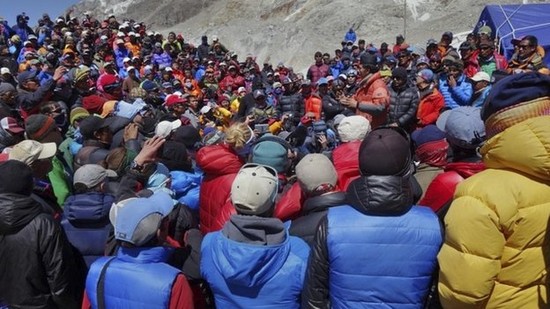Climbers are descending from Everest base camp, amid uncertainty over this year’s climbing season after 16 guides were killed in an avalanche.
A row over local guides’ share of revenue from foreign climbers erupted after last week’s deadly accident, prompting some to threaten a boycott.
Sherpas also want better rescue and treatment facilities for guides.
If others descend, some fear it could effectively end plans to climb the world’s highest mountain this year.
Ang Tshering Sherpa, the president of the Nepal Mountaineering Association (NMA), told BBC Nepali’s Surendra Phuyal that was a distinct possibility if the majority of climbers decided to abandon climbing.
But Madhusudan Burlakoti, a tourism ministry official, hoped that some teams might still climb. Sherpas have been in talks over these issues with the Nepalese government.
More than 300 foreign climbers were preparing to climb Everest this year, but the tense aftermath of the avalanche that killed 13 Sherpas and left 3 missing presumed dead dashed hopes and left many climbers disturbed and shocked, our correspondent reports.
Last Friday’s avalanche was the single deadliest accident in modern mountaineering on the world’s highest peak.
It struck an area just above Everest base camp at 5,800m (19,000ft).
Sherpa conditions
Sherpas can earn up to $8,000 (£4,800) in the three-month Everest climbing season, more than 10 times the average wage in Nepal, which remains one of Asia’s poorest nations.
But BBC South Asia correspondent Andrew North says that does not look so good when the government is earning millions of dollars each year in fees for climbing permits. Some guiding companies charge clients up to $60,000 (£36,000) per person.
The guides who lost their lives had climbed up the slope early in the morning to fix ropes for climbers and prepare the route.
The avalanche struck a passage called the Khumbu Icefall, which is riddled with crevasses and ice boulders that can break free without warning.
Although relatively low on the mountain, it is one of its most dangerous points – but there are no safer paths along the famous South Col route first scaled by Sir Edmund Hillary and Tenzing Norgay in 1953.
Sherpas often make 20-25 round trips to carry kit and supplies to advanced camps, exposing them to greater risk.
Everest has been scaled by more than 3,000 climbers since 1953.






